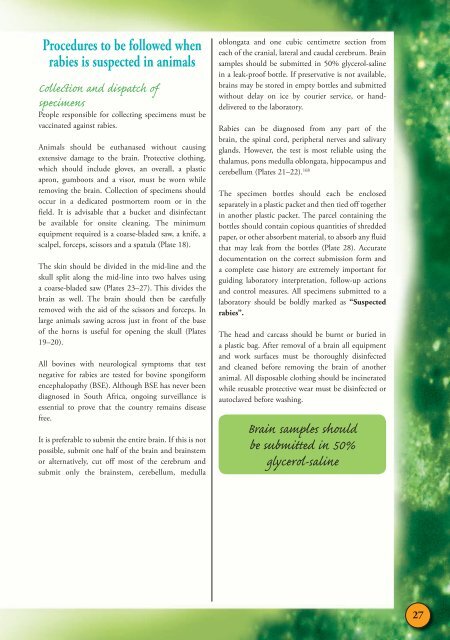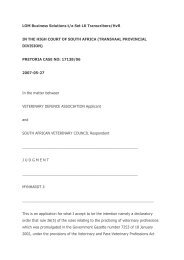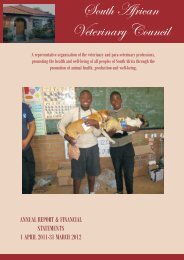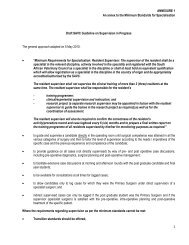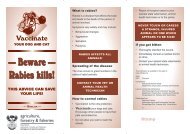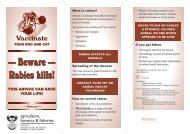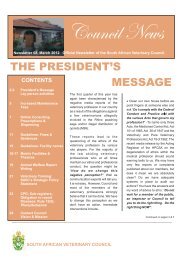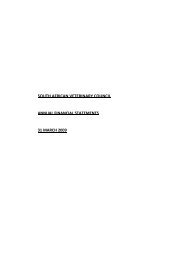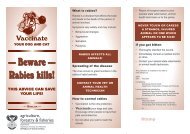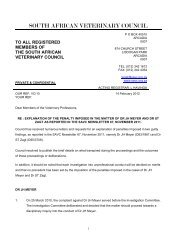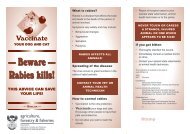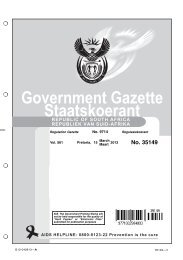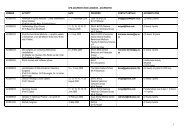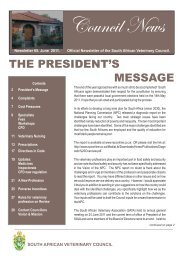Rabies Guide 2010.pdf - the South African Veterinary Council
Rabies Guide 2010.pdf - the South African Veterinary Council
Rabies Guide 2010.pdf - the South African Veterinary Council
Create successful ePaper yourself
Turn your PDF publications into a flip-book with our unique Google optimized e-Paper software.
Procedures to be followed when<br />
rabies is suspected in animals<br />
Collection and dispatch of<br />
specimens<br />
People responsible for collecting specimens must be<br />
vaccinated against rabies.<br />
Animals should be euthanased without causing<br />
extensive damage to <strong>the</strong> brain. Protective clothing,<br />
which should include gloves, an overall, a plastic<br />
apron, gumboots and a visor, must be worn while<br />
removing <strong>the</strong> brain. Collection of specimens should<br />
occur in a dedicated postmortem room or in <strong>the</strong><br />
field. It is advisable that a bucket and disinfectant<br />
be available for onsite cleaning. The minimum<br />
equipment required is a coarse-bladed saw, a knife, a<br />
scalpel, forceps, scissors and a spatula (Plate 18).<br />
The skin should be divided in <strong>the</strong> mid-line and <strong>the</strong><br />
skull split along <strong>the</strong> mid-line into two halves using<br />
a coarse-bladed saw (Plates 23–27). This divides <strong>the</strong><br />
brain as well. The brain should <strong>the</strong>n be carefully<br />
removed with <strong>the</strong> aid of <strong>the</strong> scissors and forceps. In<br />
large animals sawing across just in front of <strong>the</strong> base<br />
of <strong>the</strong> horns is useful for opening <strong>the</strong> skull (Plates<br />
19–20).<br />
All bovines with neurological symptoms that test<br />
negative for rabies are tested for bovine spongiform<br />
encephalopathy (BSE). Although BSE has never been<br />
diagnosed in <strong>South</strong> Africa, ongoing surveillance is<br />
essential to prove that <strong>the</strong> country remains disease<br />
free.<br />
It is preferable to submit <strong>the</strong> entire brain. If this is not<br />
possible, submit one half of <strong>the</strong> brain and brainstem<br />
or alternatively, cut off most of <strong>the</strong> cerebrum and<br />
submit only <strong>the</strong> brainstem, cerebellum, medulla<br />
oblongata and one cubic centimetre section from<br />
each of <strong>the</strong> cranial, lateral and caudal cerebrum. Brain<br />
samples should be submitted in 50% glycerol-saline<br />
in a leak-proof bottle. If preservative is not available,<br />
brains may be stored in empty bottles and submitted<br />
without delay on ice by courier service, or handdelivered<br />
to <strong>the</strong> laboratory.<br />
<strong>Rabies</strong> can be diagnosed from any part of <strong>the</strong><br />
brain, <strong>the</strong> spinal cord, peripheral nerves and salivary<br />
glands. However, <strong>the</strong> test is most reliable using <strong>the</strong><br />
thalamus, pons medulla oblongata, hippocampus and<br />
cerebellum (Plates 21–22). 168<br />
The specimen bottles should each be enclosed<br />
separately in a plastic packet and <strong>the</strong>n tied off toge<strong>the</strong>r<br />
in ano<strong>the</strong>r plastic packet. The parcel containing <strong>the</strong><br />
bottles should contain copious quantities of shredded<br />
paper, or o<strong>the</strong>r absorbent material, to absorb any fluid<br />
that may leak from <strong>the</strong> bottles (Plate 28). Accurate<br />
documentation on <strong>the</strong> correct submission form and<br />
a complete case history are extremely important for<br />
guiding laboratory interpretation, follow-up actions<br />
and control measures. All specimens submitted to a<br />
laboratory should be boldly marked as “Suspected<br />
rabies”.<br />
The head and carcass should be burnt or buried in<br />
a plastic bag. After removal of a brain all equipment<br />
and work surfaces must be thoroughly disinfected<br />
and cleaned before removing <strong>the</strong> brain of ano<strong>the</strong>r<br />
animal. All disposable clothing should be incinerated<br />
while reusable protective wear must be disinfected or<br />
autoclaved before washing.<br />
Brain samples should<br />
be submitted in 50%<br />
glycerol-saline<br />
27


